Ask a Scientist – Geomorphologic Analysis
Ask a Scientist – Basin Areas
The Impacts of Pharmaceuticals in a Temperate Stream Dominated By Wastewater Effluent
Each year, the Iowa Water Center (IWC) offers two grant research competitions for the water community, with one being restricted to Iowa while the other is open to nationwide projects.
One of the national projects that we [IWC] have funded is centered around the ecological impacts of pharmaceuticals in effluent-dominated streams. The primary investigator of this project is Gregory LeFevre, with assistance from graduate student Hui Zhi.
This has been an ongoing project for multiple years, with the first year of earning the grant being 2017. You can read their initial abstract from 2017 here. This research project was also recently published in the journal Environmental Science and Technology, which you can read here.
Over two years, the team measured and monitored the spatiotemporal, or the dynamic of changes in space and time, of the levels of different pharmaceutical compounds in the wastewater treatment plant that is nearby North Liberty, Iowa. After gathering the necessary data, they then analyzed the information to figure out exactly what occurred when the pharmaceuticals entered the effluent-dominated stream.
“Most of the time, people think about effluent dominated streams being in a dry region,” explained LeFevre, “but they’re actually much more common than people would expect in temperate regions.”
North Liberty is considered a medium sized community, with relatively small streams, which is quite common to find in temperate regions of the United States. LeFevre explained that this can change the dynamic of the chemicals in the stream, which is what inspired the goal behind this project.
The main objective when this project was initially coming to life was to understand how chemical mixtures occur, but then also how they change throughout time and space along the stream. The idea is to understand specifically what these mixtures are, how they evolve, and then connect those patterns with biological effects.
After collecting water samples from the stream, the team sent these samples to the School of Freshwater Sciences at UW-Milwaukee, where a co-investigator of this project, Rebecca Klaper, is the Director of the Great Lakes Genomics Center. Klaper and her team, consisting of Dana Kolpin and Luke Iwanowicz, added these water samples to laboratory raised fish in order to test the effects that the water had, or didn’t have, on the fish at the genetic level.
In addition to this investigation portion of the project, Klaper and her team also raised native fish in a laboratory, then caged and added them to the same stream for four days. After the four days, the fish were then dissected and are currently undergoing genetic analysis.
“Chronic exposures can have long-term biological effects to fish,” said LeFevre. “What we’re interested in is how these potential mixtures might accidentally change through the aquatic environment for the fish, as well as how the mixtures themselves might change because of other variables.”
Even though they have gathered everything necessary for this particular study, the team is not finished yet. Along with assessing the data that they have collected; the team is planning on utilizing this stream site to its maximum potential for future projects relating to fish habitats non-target analysis.
Gregory LeFevre is an assistant professor in Civil and Environmental Engineering at the University of Iowa, as well as an assistant faculty research engineer at IIHR – Hydroscience & Engineering. If you would like to learn more about his work, you can visit his laboratory website here, and his Google Scholar page here.
By: Meghan Hanley, Outreach and Engagement Assistant
University of Iowa’s IIHR–Hydroscience and Engineering Expands Water Assessment Modeling
The word “ghost” has adapted a new meaning, in addition to the initial Halloween Casper-the-friendly-kind, for the water community. GHOST is a hydrologic model which allows users to be able to gather information, including land use, topography and geology, and be able to create predictions for streamflows. The name is an acronym, standing for Generic Hydrologic Overland-Subsurface Toolkit.
I had the opportunity to, virtually, meet and talk to Antonio Arenas Amado, to learn more about the creation, development and future of the GHOST program. Arenas is an associate research engineer at the University of Iowa’s IIHR–Hydroscience and Engineering and the Iowa Flood Center and a member of the team that created the GHOST program.
This program took quite a bit of time to finally come to life. The code development process and adaption of the model took around one year, with hours on end writing and verifying code and equations. Prior to the start of the development, the team had spent an abundance of time researching existing models, which helped them get a sense of an idea for what they wanted, or didn’t want, in their model.
This project originally started off by attempting to use a code already created by Penn State University, but it was later discovered that there would be several steps to adapt the existing model to what was needed for Iowa. The team created a new model, which is now the GHOST program, and continued to keep the same framework from the Penn State model.
Models are typically classified by the range of time that the model uses for data. The GHOST model is a long-term, continuous model, meaning that it can run and gather data for multiple years without stopping. Using this type of model allows the program to assess all of the activity within that time frame and identify patterns in drainage and flooding.
“If you imagine, when one drop [of water] falls from the sky, there are a bunch of potential paths for that drop of water to make it, or not make it, to a stream,” said Arenas, “so that’s what we try to account for in using this computational model.”
The inspiration for the creation of the GHOST model started off with a project for the Iowa Watershed Approach (IWA). The IWA, co-lead by IIHR–Hydroscience and Engineering at the University of Iowa, focuses on mitigating flood damage, which then led to the spark for the GHOST program.
There are a vast number of potential applications that the GHOST model can be used for. Arenas explained that a main use of this model in Iowa has been to help with the flooding issues that have occurred in the past years. So far, it has helped the state of Iowa discover new mitigation strategies for watersheds. Arenas also shared that where this program has helped in flood mitigation, it can also help in studying droughts as well.
“I think it is fair to say that we have more to do with the GHOST program than we have already done,” said Arenas.
Arenas shared a few examples of where he can envision GHOST being used or expanding in the future. First, he mentioned how much this program would be able to help with drought research and mitigation. Next, he mentioned that they were also hoping to add a water quality component to the model. Lastly, he explained the team has hopes of expanding the capacity of the computer speed of GHOST in order to be able to use it in larger watersheds and grow out of the small-medium watershed-level they are currently modelling.
The team that created the GHOST model consists of Antonio Arenas Amado, Dr. Marcela Politano and Dr. Larry Weber of the University of Iowa Flood Center and IIHR–Hydroscience and Engineering.
By: Meghan Hanley, Outreach and Engagement Assistant
Art and Conservation: The Interdisciplinary Vision of Felix Summers
Getting into Soil and Water 2020
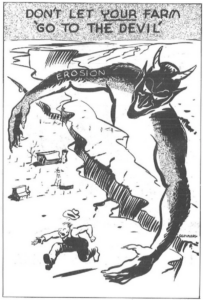
Artists are not usually the first people who spring to mind when thinking about soil conservation in the United States. In the 1950s and 60s however, Felix Summers’ artwork introduced the Soil Conservation Service (now the Natural Resources Conservation Service) and big ideas about conservation farming to thousands of Americans. Even if they did not know his name, rural communities knew Felix Summers’ vivid, one-panel cartoons pointing out the dangers of soil erosion and the value of conservation farming.
In the mid-20th century, the Soil Conservation Service (SCS) used a team of technical illustrators in the Information Office to bring SCS ideas and publications to life. Professional artists illustrated complex scientific and engineering concepts not easily conveyed in text or photography. The tremendous number of informational bulletins, pamphlets, and other materials that flowed from the SCS in the mid-20th century often featured the work of these in-house illustrators. While most of their work illustrated specific manuals, guides, and public-facing pamphlets, the Information Division also provided a constantly expanding catalog of conservation cartoons to field offices. Field office staff across the country published the cartoons that best addressed local issues in local newspapers. These cartoons were many Americans’ first introduction to the SCS and conservation agriculture. Most of the over 400 cartoons in the artwork catalog were the work of one illustrator, Felix Summers.
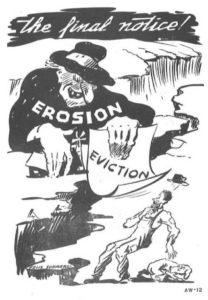
Making His Way to the SCS
Felix Summers came to the SCS by way of two very different places: the New York City art scene of the 1930s and the Mills County Iowa SCS office. He began his art career at the University of Nebraska and went on to do post-graduate work at Yale, where he studied with muralist Eugene Savage. Summers’ style reflected the contemporary influence of the Regionalist school made famous by other Midwestern artists such as Thomas Hart Benton, John Steuart Curry and Grant Wood. Iowan farmers since before the Civil War, Summers’ family was steeped in agriculture. His rural upbringing outside of Strahan, Iowa informed his artistic focus on scenes of agrarian and rural life. Despite his rural roots, Summers spent five years painting murals in decidedly non- rural Manhattan department stores and nightclubs, including the storied Cotton Club and the El Morocco. World War II deferred Summers’ early artistic career as a muralist when the Army drafted him to serve with the combat engineers. After the war, the art world’s tastes moved away from Summers’ agrarian Regionalism – rejecting the familiar, rural scenes that were his specialty.
Showcasing His Skills
Looking for work after the war, Summers returned home to Iowa and took an entry-level job as a conservation aid at the Mills County office of the SCS. His skill at the drafting table lent itself well to conservation planning. Combining a growing belief in the mission of the SCS with his desire for artistic expression, Summers spent his evenings and weekends drawing cartoons designed to spread the gospel of soil conservation. His work drew the attention of SCS leadership, and he was soon promoted to the regional office in Milwaukee as a full-time illustrator. Beginning in 1948, the SCS began distributing Summers’ cartoons nationally. An agency reorganization moved Summers to Lincoln, Nebraska where he worked as an illustrator in the Midwest Regional Technical Service Center until his retirement in 1972. Upon his retirement, Summers received the USDA’s Superior Service Award for his illustrative work in service of conservation. Felix Summers died in 1987 at the age of 77.
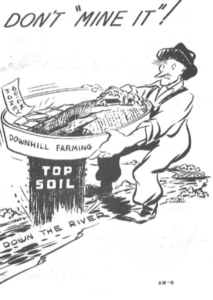
Reaching a Wider Audience
The work of illustrators like Summers helped the SCS reach a wide audience not already familiar with the work of the SCS or the conservation movement. Cartoons provided a shorthand that quickly and succinctly conveyed why the work of the SCS mattered. Photographs provided examples, but art conveyed big ideas quickly and succinctly. Armed with something to say about conservation, the same artist who was out of style in post-war Manhattan nightclubs was right at home in midwestern newspapers. Summers’ cartoons drew in people who would ordinarily scan past what might have seemed like dry and technical articles about federal conservation efforts. Moreover, he conveyed SCS messages in a visual shorthand that spread the word to even the casual reader. When interviewed in 1952, Summers summed up his artistic approach: “to speak the language of farmers on their own terms, but do it pictorially. I wanted to interpret for other people all the sweat, strain, and worry that goes into farming.”
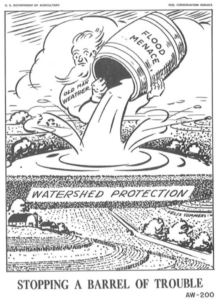
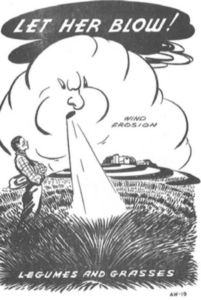
By summing up the importance of conservation agriculture in one panel cartoons, Summers provided an extremely efficient message that reassured those farmers and ranchers already practicing conservation and challenged those who were not. A New York muralist might seem an unlikely champion for conservation, but Summers widely distributed work remains a testament to the importance of a truly interdisciplinary approach to conservation.
Shelby Callaway
Historian, Natural Resource Conservation Service US Department of Agriculture
All images are from a copy of the mid-century SCS artwork catalog preserved in the Doug- las Helms Collection in the Special Collections Division of the USDA’s National Agricultural Library in Beltsville, Maryland.
Teaching About Land Use and Watersheds With PEWI
Getting into Soil and Water 2020
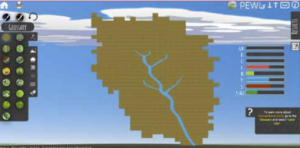
What educational strategies encourage students to learn about soil and water?
- “Telling” is adequate.
- “Showing” is helpful.
- But “making it happen” can be the most powerful.
PEWI is a digital game-based learning (DGBL) tool created by Iowa State University that relies on simulation, one of the most powerful and reliable ways to make phenomenon happen for students in the classroom. Simulation is one of the ways to “make it happen.” Simulation fits the theory of experiential learning and other inquiry-based approaches to education. Lessons that rely on simulation show students the results of their inquiries, and involve them in making sense of the world by systematically asking good questions.
PEWI is an online game that teaches about agricultural land uses, watersheds, water quality, biodiversity, ecosystem services, and the scientific tools that land managers rely upon, such as topographic, soil, and drainage maps (Figure 1). PEWI stands for People in Ecosystems Watershed Integration (Chennault et al., 2016; Schulte et al., 2010) and has been used by teachers in middle school through university. PEWI even has a “drone” mode.
PEWI can be played at no cost at: https://www.nrem.iastate.edu/pewi/
Okay – so computer games in schools aren’t new. They have been used in classrooms by nearly 80% of middle and high school teachers (An et al., 2016), but a widespread complaint of teachers is the lack of correlation with educational subject matter (Bourgonjon, 2013). There are very few games that fit soil and water like PEWI. We’ve demonstrated PEWI to high school and community college agriculture and science teachers, and they really get it.
PEWI Land and Water
PEWI consists of a visual representation of 5,888 acres (2,382 hectare) with geophysical features combined from two Iowa landforms, the Des Moines Lobe and the Southern Iowa Drift Plain (Prior, 1991). Fifteen land uses can be applied or removed, including: corn (2 planting systems), soybeans (2 planting systems), mixed fruits and vegetables, alfalfa, grass hay, cattle (2 pasture systems), wetlands, prairie, forest, and woody bioenergy. PEWI provides maps for students to access to explain differential movement of water, nutrients, and sediment; comparative growth of vegetation; and maps to show historical flood frequency, sub-watershed boundaries, soil drainage class, soil type, topography, and crop yields. Instructors may set precipitation at seven levels from dry (24.58 in or 62.43 cm) to wet (45.10 in or 114.55 cm) or permit random assignment.
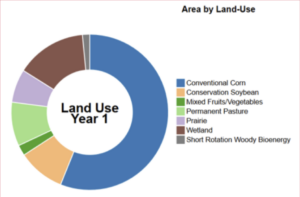
Simulation
Simulations are preferred by teachers because they allow students to “safely and cost- effectively acquire skills and attitudes which are hard to get by rote learning” (Bellotti et al.,
2013, p. 2). Simulations can be paired with instructional approaches such as collaborative and team-based learning, as well as lecture, laboratory, and field trips. Annetta (2008) showed that collaboration in simulation game playing can enhance learning.
PEWI is not a “farm simulation” where students step into the role of producer and grow crops. Instead, students in lesson plans are given watershed-level challenges like this: The current nitrate level in ppm in the PEWI River exceeds desired levels. Select the type, acreage amount, and location of land uses on the PEWI Watershed to lower the level of nitrate to an acceptable level.
Without a simulation like PEWI, consider how difficult it would be for scientists, state and local government, and community members to generate enough evidence to add or remove a land use, such as substituting prairie for row crops; or row crops for prairie, in a particular location. The evidence, pro or con, would take years to accumulate. Monitoring is expensive and someone has to staff the equipment. Someone owns the land, which brings up economic and ethical questions. A simulation like PEWI makes the query-response process fast, easy (Figure 2), and poses fewer ethical dilemmas than for the real situation.
National Educational Standards
A simulation also fits with national standards for science, the Next Generation Science Standards (NGSS) (National Research Council [NRC], 2012). Simulation fits an NGSS practice definition of “trying things again and again but without real materials” (NRC, 2012). The standards for agricultural education, the National Agriculture, Food, and Natural Resources Standards (AFNR; National Council for Agricultural Education, 2015), also features learning by students about cycles and feedback, which are satisfied by simulation software that require students to articulate a goal and interact with PEWI to achieve it. The PEWI team has analyzed the tool for alignment to both standards. PEWI aligned with nine high school level NGSS student Performance Expectations categories. For AFNR, the PEWI evaluation provided evidence for alignment of 10 standards and 17 indicators from the areas of Environmental Service Systems, Natural Resource Systems, and Plant Systems. Release of an online Teachers Guide for PEWI is planned for the future.
Acknowledgements
Iowa State University Departments of Natural Resources Ecology and Management; Agricultural Education and Studies; and Agronomy; The McKnight Foundation; US Forest Service Northern Research Station; and USDA McIntire-Stennis Program (IOW5423, IOW5534) supported development of PEWI and the project of aligning with educational standards. We thank Katelyn Anderson, Carrie Chennault, John Tyndall, Robert Valek, John VanDyk, and science reviewers, undergraduate research assistants, and K-16 educators who contributed to PEWI’s development.
Nancy Grudens-Schuck, PhD
Associate Professor Agricultural Education and Studies
Iowa State University
Lisa A. Schulte Moore, PhD
Professor Natural Resource Ecology and Management
Iowa State University
References:
An, Y-J., L. Haynes, A. D’Alba, and F. Chumney. 2016. Using educational computer games in the classroom: Science teachers’ experiences, attitudes, perceptions, con- cerns, and support needs. Contemp. Issues Tech. Teach. Ed. 16(4): 415-433.
Bourgonjon, J., F. De Grove, D. De Smet, J. Van Looy, R. Soetaert, and M. Valcke. 2013. Acceptance of game-based learning by secondary school teachers. Computers Educ. 67: 21-35. doi:10.1016/j.compedu.2013.02.010
Chennault, C.M., L.A. Schulte, and J.C. Tyndall. 2016. People in Ecosystems Water- shed
Integration: A web-based learning tool for evaluating ecosystem service tradeoffs from watersheds. J. Soil Water Cons. 71: 31A-36A. doi:10.2489/jswc.71.2.31A
National Council for Agricultural Education (NCAE). 2015. National Agriculture, Food, and Natural Resources (AFNR) career cluster content standards, rev. 2015. Indianapolis, IN. https://thecouncil.ffa.org/afnr/
National Research Council (NRC). 2012. A framework for K-12 science education: Practices, crosscutting concepts, and core ideas. Washington, DC: NAP.
Natural Resource Ecology and Management. 2018. People in Ecosystems Watershed Integration (PEWI 3.0). Ames, IA: Iowa State University. Available at: https://www. nrem.iastate.edu/pewi/. doi: https://doi.org/10.31274/nrem-20191121-1
Schulte, L.A., J. Donahey, L. Gran, T. Isenhart, and J.C. Tyndall. 2010. People in Ecosystems Watershed Integration: A dynamic watershed tool for linking agroeco- system outputs to land use and land cover. J. Soil Water Conserv. 71(2): 31A-36A. doi:10.2489/jswc.71.2.31A
Managing Phosphorus for Water Quality in Iowa Lakes
Getting into Soil and Water 2020
Nutrient pollution in surface waters – or eutrophication – is a grave social and economic concern for communities across Iowa. Over 90 percent of Iowa lakes and reservoirs are characterized as eutrophic due to very high nutrient levels (IDNR, AQuIA Database, Carlson, 1977). This means that our lakes are vulnerable to algal blooms during the summer months (Figure 1). Algal blooms are one of the most visible and dangerous symptoms of eutrophication as these blooms are linked to concerns such as fish kills and the release of toxins (Smith, 2009).
During the summer of 2018, researchers with the Ambient Lake Monitoring Program found the toxin microcystin in 72 percent of their 128 study lakes across Iowa (IDNR, AQuIA Database). Microcystin is a liver toxin that may be produced during algal blooms by some types of cyanobacteria, commonly called blue-green algae. Exposure to this toxin can cause skin irritation, gastrointestinal distress, and liver damage (Carmichael, 2001). Toxic algal blooms are an obvious public health concern, and they jeopardize the recreational economies of Iowa’s water bodies – an industry valued at around $1 billion statewide, annually (Jeon et al., 2016). As such, there is a pressing need to manage algal blooms in order to protect public health and recreational economies across our state.
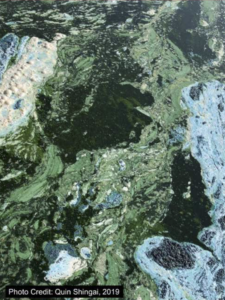
Managing Inputs
Preventing algal blooms requires that we reduce nutrient inputs to Iowa surface waters. For lakes and reservoirs, it is especially important to manage phosphorus inputs. Phosphorus is an essential nutrient for all organisms. However, high phosphorus levels in lakes can be “too much of a good thing,” and fuel algal blooms dominated by cyanobacteria (Schindler et al., 2016). Lake phosphorus management typically focuses on reducing watershed phosphorus losses with practices such as cover crops and buffer strips. These efforts are critical for eutrophication management; however, it is also important to consider how phosphorus can be recycled within water bodies. Specifically, phosphorus stored in the sediments at the bottom of a lake can be released into the overlying water if the sediments are disturbed or if chemical conditions change (Søndergaard et al. 2003). This process is referred to as internal phosphorus loading and can maintain high, in-lake phosphorus concentrations even if watershed nutrient inputs are reduced, perpetuating poor water quality (Jeppesen et al., 2005).
Unfortunately, the mechanisms that control internal phosphorus loading are poorly described for the shallow lakes and reservoirs that we have in Iowa. This knowledge gap makes the management of internal phosphorus inputs extremely difficult. How can you prevent something if you don’t know when, where, or why it’s happening? The goal of my graduate research with the Wilkinson Limnology Lab at Iowa State University is to start answering the “when, where, and why” of internal phosphorus loading in shallow lakes. With funding support from the Iowa Water Center, we constructed a sediment core incubation system to measure internal phosphorus loads in Iowa lakes and test the underlying mechanisms (Figure 2). Over the course of last summer, our research team visited several study lakes in western Iowa and collected cores of lakebed sediments and the overlying water. We took these cores back to the laboratory and incubated them under different conditions that lakebed sediments might experience naturally, such as low versus high oxygen levels. Every day the cores were incubated, we collected samples of the overlying water and tested the phosphorus concentration. This measurement allowed us to determine if the sediments were releasing phosphorus over time and if so, how much.
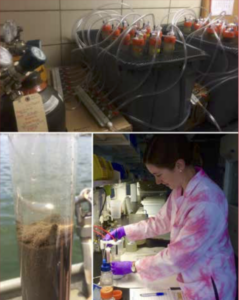
Investigating Mechanisms
Preliminary results from the past summer indicate moderate to high internal phosphorus loading rates in our study lakes. The influence of oxygen levels on sediment phosphorus release varied across different study lakes and between shallow versus deep sites within each lake. Next year, we will continue to investigate the chemical mechanisms responsible for the observed patterns. Testing the mechanisms that control sediment phosphorus release can inform targeted management approaches to reduce internal loading. It is important to note that efforts to reduce internal phosphorus loading will only be effective if watershed inputs are also controlled. Addressing eutrophication in Iowa water bodies requires bold management of both external and internal phosphorus loading.
Ellen Albright
Graduate Research Assistant Department of Ecology, Evolution and Organismal Biology at Iowa State University
References:
Carlson, R.E. 1977. A trophic state index for lakes. Limnology and Oceanography, 22(2): 361-369.
Carmichael, W.W. 2001. Health effects of toxin-producing cyanobacteria: “The CyanoHABs”. Human Ecological Risk Assessment, 7(5): 1393-1407.
Iowa Department of Natural Resources (IDNR). 2018. Water Quality Monitoring and Assessment Section. AQuIA [database]. Retrieved from https://programs. iowadnr.gov/aquia/.
Jeon, H., Ji, Y., and Kling, C.L. 2016. A report to the Iowa Department of Natural Resources: The Iowa Lakes Valuation Project 2014. Prepared February 2016, URL: http://www.card.iastate.edu/lakes/report-to-the-iowa-department-of- natural-resources-2014.pdf
Jeppesen, E., Sondergaard, M., Jensen, J.P., Havens, K.E., Anneville, O., Carvalho, L., et al. 2005. Lake responses to reduced nutrient loading — an analysis of contemporary long-term data from 35 case studies. Freshwater Biology, 50(10): 1747–1771.
Schindler, D.W., Carpenter, S.R., Chapra, S.C., Hecky R.E., and Orihel,
D.M. 2016. Reducing phosphorus to curb lake eutrophication is a success. Environmental Science & Technology, 50(17): 8923-8929.
Smith, Val H. 2009. “Eutrophication.” In The Encyclopedia of Inland Waters, edited by Gene E. Likens, 61-73. Amsterdam: Elsevier.
Søndergaard, M., Jensen, J.P., and Jeppesen, E. 2003. Role of sediment and internal loading of phosphorus in shallow lakes. Hydrobiologia, 506-509: 135- 145.
Studying Nature in Nature
Getting into Soil and Water 2020
For the past four summers, Iowa State University’s College of Design Associate Professor Alex Braidwood has been teaching a field study class at Iowa Lakeside Lab Regents Resource Center called Acoustic Ecology. Lakeside Lab is a biological field research station in the northwest corner of Iowa founded in 1909 with the stated goal of providing a place for “the study of nature in nature.” This mission continues to this day. As part of this mission, the Acoustic Ecology course that Braidwood has developed brings together undergraduate and graduate students from the sciences and the arts each summer
to investigate the soundscape of Lakeside Lab and the surrounding areas. The region is dotted with prairie, wetland, and even woodland preserves where Braidwood both collects audio for his own work and exposes students to the process of nature sound recording during the two-week, two credit course.
The Acoustic Ecology class is a dynamic field study experience that involves a great deal of work in the field to put into practice the things that are discussed and demonstrated in the classroom. The course also involves a series of listening exercises to get everyone familiar and comfortable with the idea of active listening, a skill anyone can spend more time working on. The group moves through various exercises, some stationary and some mobile, to regain a level of focus on their ears and on listening – not just hearing, but listening. Hearing is the mechanical action performed by the ear and its subsequent parts. Listening, however, is much different. Listening involves the mind and has a level of intention to it that is not necessarily present in hearing. Listening is also a skill that can be improved upon.
These types of experiences provide an introduction into the lessons that will follow over the two-week class and are reinforced throughout the coursework. The class is part seminar, part field study, part technical demonstration, and part studio/lab. Students are shown early in the course a variety of audio recording techniques as well as taught how to use different sound recording devices and microphone configurations. The benefits of different recording systems and tactics are discussed, and students are given time to practice in the field as the class takes exploratory trips to various locations. The goal of the trips is also to determine sites and specific locations for capturing early morning recordings that begin pre-dawn and continue after sunset. This time of wildlife vocalization is referred to as the “dawn chorus” and is one of the more dynamic times for capturing an acoustic signature of a given place. After bringing the various field recordings back to the lab, the sounds are analyzed, processed, marked up, and observed. Students make observations about species diversity, uniqueness of the environment, impact of human sound, and anything else they find relevant for discussion.
In addition to recording techniques and equipment, the course covers a variety of professional audio editing and mastering techniques for the creation of audio pieces to be shared online. The end result is project-based and completed in the form of narrative audio pieces edited together to tell the story of what has been collected and observed. These audio pieces are in an audio format similar to popular edited podcasts such as RadioLab, 99 Percent Invisible, and This American Life.
If interested, registration will be open in early 2020 on the Iowa Lakeside Lab website. For summer 2020, the course has been renamed “Interacting with Nature Sound” to better communicate the goals and outcomes of this field study course at the intersection of art, science, and nature.
This intersection of art, science, and nature also describes the other work Alex Braidwood is involved with at Iowa Lakeside Lab as Director of their Artist-in-Residence (AIR) program. Since 2016, Braidwood has been in this position and has grown the program into a residency that brings artists working in any medium to Lakeside Lab from all over the country, and now, the world. The program welcomed its first international artist, a Dutch composer, in 2019. The residency has a competitive application process and focuses on artists who work at the intersection of art, science, and nature. SciArt, as it is sometimes referred, is an exploding area of contemporary art, and individuals working in this space find a great deal of value embedding in a place like Iowa Lakeside Lab. Artists are invited to visit classes, participate in field study outings, and share their work with the Lab community as well as the public in the Great Lakes Region of Iowa through bi-weekly public open studio events.
Braidwood has positioned the residency program within the lab on the ideas exemplified in his tagline for the program which is, “Artists and scientists are both asking questions about the world, they’re just doing it in different ways.” This really does summarize how artists engage with the Lab as they explore the different possible relationships available to them in this unique environment in the northwest corner of Iowa.
Alex Braidwood
Associate Professor, Graphic Design
Director, Iowa Lakeside Lab Artist-in-Residence Program Iowa State University
Celebrating the Conservation Profession While Shaping its Future
Getting into Soil and Water 2020
When the clock struck midnight on January 1st, 2020, the Soil and Water Conservation Society began the celebration of its 75th Anniversary. Seventy five years of being the premier organization for professionals who practice and advance the science and art of natural resource conservation throughout this nation and beyond. Seventy five years of cultivating, through local and national leadership, a community of informed dynamic individuals whose contribution, has created and continues to create, a bright future for agriculture, the environment and society.
Coming up on this incredible achievement moves one to reflect thoughtfully on the past and, as the ninth CEO of the Society, I am compelled to set a course for the future. With the world around us changing at an unprecedented pace, it is hard to predict what the Society and the conservation profession will look like in the next 75 years but I know it will include the Soil and Water Conservation Society as an inclusive and dexterous organization ready to respond to the needs of our members and our natural resources.
Towards this goal of inclusion, the Society started as, and remains today, one of very few interdisciplinary professional associations. As Hugh Hammond Bennett, founder of the Society and the USDA Natural Resources Conservation Service, wrote seventy five years ago in the first edition of our Journal of Soil and Water Conservation, “For efficient forward movement of the national program of soil and water conservation…there will always be a need for well-trained specialists. There will always be a need for agronomists, geologists, engineers, foresters, botanists, hydrologists, and others…teachers, industrialists, students, doctors, union members, ministers, bankers, editors and farmers – people in every walk of life.”
The Society recognized early on the strength in having many diverse voices at the table and found a role for itself in convening those with divergent interests towards a common goal. As conservation grows, the professions involved that can benefit from the Society grows as well and we will expand our reach to support the individuals and organizations across many fields. We will make the Society more accessible by seeking out different perspectives and through opportunities like our office wide memberships and community and corporate partnerships. As the first woman CEO of the Society, I take this charge particularly seriously, understanding personally not only the absolute necessity but the benefit of bringing those to the table that have not been invited before.
We will learn from the past and embrace the future. We will continue to include the voice of the next generation of conservationists. The work we have done to recruit and build the next generation of conservationists has been one of the most exciting aspects of my couple years
as CEO because it makes the Society sustainable and ensures a bright future for soil and water conservation. We have unveiled a career center that offers job opportunities and other services to members including resume reviews. We created career profiles of our members, so that the younger generations can see the diversity of conservation professionals. We have developed an online student and early career professional development guide and enhanced the conference experience of our student attendees through various activities, including pairing them up with mentors in their desired future fields. We started a robust intern program. Our work will be intergenerational.
We will support our members and chapters. The Society’s foundation is built on our chapter model, which extends across the U.S. and into Canada. Including out impactful student chapters, like the Iowa State University Soil and Water Conservation Club, which creates and delivers the publication you hold in your hands. Through our new conservation professional service offerings we will support and amplify the shared missions of our chapters and partners in the nonprofit, academic, and private sectors who can depend on us to plan their next conservation event, facilitate a group of conservation professionals to generate solutions around challenges, or share their conservation story.
Clare Lindahl
CEO
Soil and Water Conservation Society